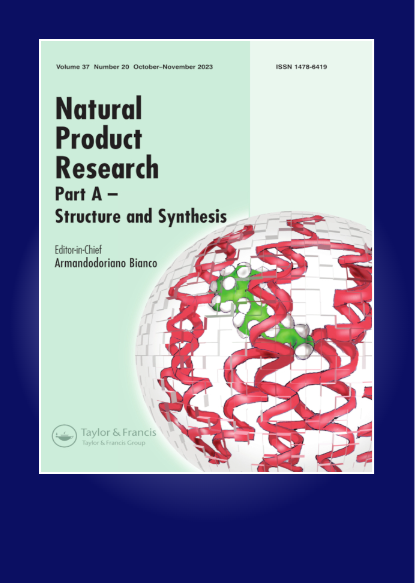Conamonin A and dihydrochalcones from the whole plants of Conamomum rubidum (Lamxay & N.S.Lý) Škorničk. & A.D. Poulsen showing anti-inflammatory and cytotoxic activities
IF 1.9
3区 化学
Q3 CHEMISTRY, APPLIED
引用次数: 0
Abstract
A new compound, conamonin A (1), was isolated from the whole plants of Conamomum rubidum with eight known dihydrochalcones (2-9). Their structures were elucidated by a combination of spectroscopic methods as well as by comparison with previously reported data. The absolute configuration of 1 was assigned by TDDFT-ECD method. Compounds 1 and 8 showed inhibitory activity against LPS-induced NO production in the RAW 264.7 cells, with IC50 values of 58.29 ± 2.88 and 81.77 ± 5.99 μM, respectively. Compounds 3/4 and 5/6 exhibited inhibitory effects, with IC50 values of 28.76 ± 1.16 and 29.89 ± 1.79 μg/mL, respectively. Compounds 2, 7-9 exhibited significant cytotoxic activity against human lung carcinoma (the SK-LU-1 cell line) with IC50 values ranging from 9.87 to 17.99 µM. This study offers valuable insights into the chemical constituents and biological activities of Conamomum rubidum, highlighting its potential as a source for discovering new anti-inflammatory and cytotoxic agents.
Conamomum rubidum (Lamxay & N.S.Lý) Škorničk. & A.D. Poulsen 全株中的 Conamonin A 和二氢查耳酮具有抗炎和细胞毒性活性。
从红花芋(Conamomum rubidum)的全株中分离出了一种新化合物--花芋头素 A(1),以及八种已知的二氢查耳酮(2-9)。通过结合光谱方法以及与之前报道的数据进行比较,阐明了它们的结构。通过 TDDFT-ECD 方法确定了 1 的绝对构型。化合物 1 和 8 对 RAW 264.7 细胞中 LPS 诱导的 NO 生成具有抑制活性,IC50 值分别为 58.29 ± 2.88 和 81.77 ± 5.99 μM。化合物 3/4 和 5/6 具有抑制作用,IC50 值分别为 28.76 ± 1.16 和 29.89 ± 1.79 μg/mL。化合物 2、7-9 对人类肺癌(SK-LU-1 细胞系)具有显著的细胞毒性活性,IC50 值为 9.87 至 17.99 µM。这项研究为深入了解红花芋的化学成分和生物活性提供了宝贵的资料,凸显了红花芋作为发现新型抗炎药和细胞毒剂来源的潜力。
本文章由计算机程序翻译,如有差异,请以英文原文为准。
求助全文
约1分钟内获得全文
求助全文
来源期刊

Natural Product Research
化学-医药化学
CiteScore
5.10
自引率
9.10%
发文量
605
审稿时长
2.1 months
期刊介绍:
The aim of Natural Product Research is to publish important contributions in the field of natural product chemistry. The journal covers all aspects of research in the chemistry and biochemistry of naturally occurring compounds.
The communications include coverage of work on natural substances of land and sea and of plants, microbes and animals. Discussions of structure elucidation, synthesis and experimental biosynthesis of natural products as well as developments of methods in these areas are welcomed in the journal. Finally, research papers in fields on the chemistry-biology boundary, eg. fermentation chemistry, plant tissue culture investigations etc., are accepted into the journal.
Natural Product Research issues will be subtitled either ""Part A - Synthesis and Structure"" or ""Part B - Bioactive Natural Products"". for details on this , see the forthcoming articles section.
All manuscript submissions are subject to initial appraisal by the Editor, and, if found suitable for further consideration, to peer review by independent, anonymous expert referees. All peer review is single blind and submission is online via ScholarOne Manuscripts.
 求助内容:
求助内容: 应助结果提醒方式:
应助结果提醒方式:


